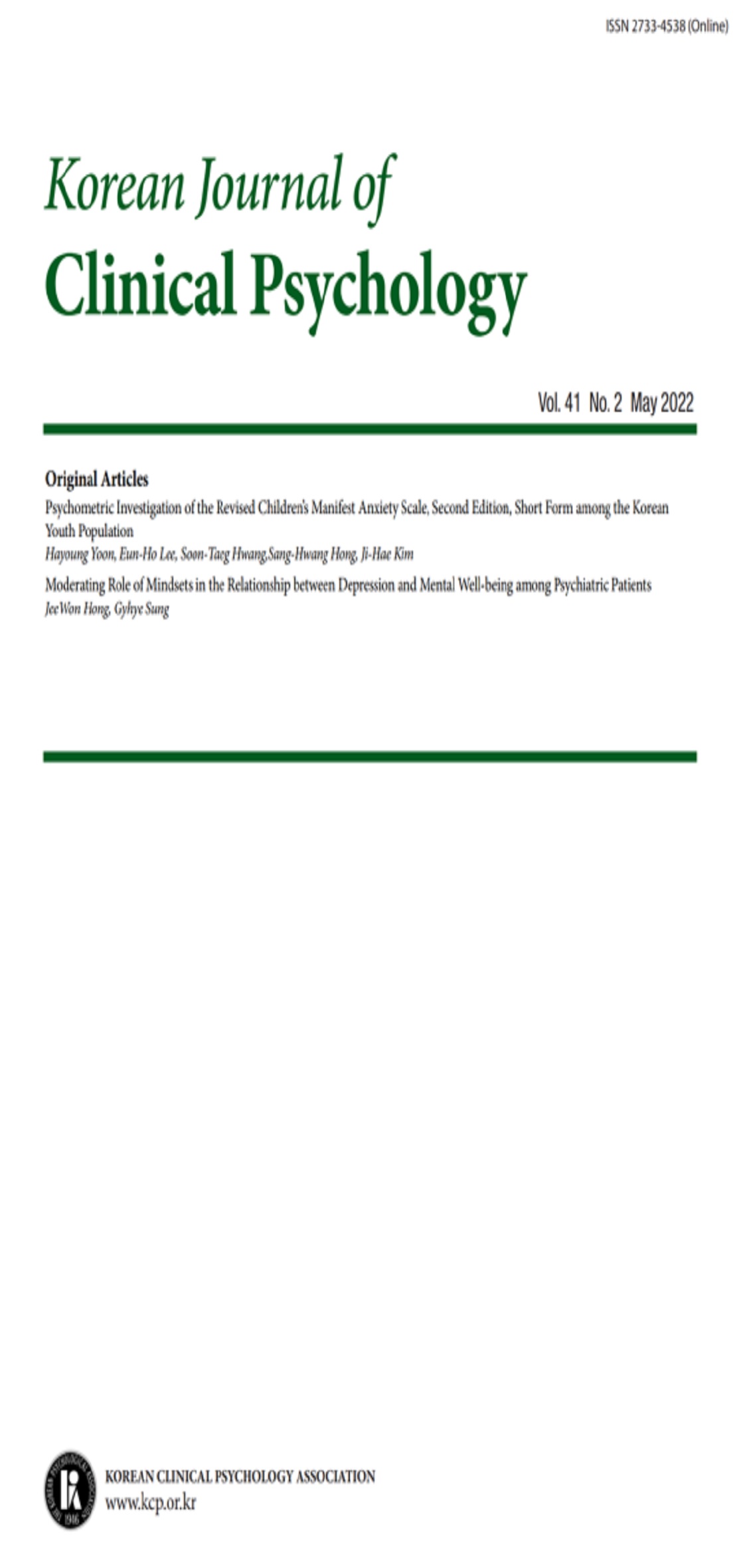open access
메뉴
open access
메뉴 E-ISSN : 2733-4538
E-ISSN : 2733-4538
본 연구에서는 대학생 집단을 대상으로 SCL-90-R의 단축형인 단축형 간이정신진단검사(Brief Symptoms Inventory-18, BSI-18)를 국내에서 활용 가능한 한국판 척도로 타당화하고자 하였다. BSI-18은 심리적 불편감을 측정하기 위한 검사도구로서, Derogatis가 기존 SCL-90-R의 9가지 증상차원척도 중 3가지 하위척도(신체화, 우울, 불안)에 해당하는 각각 6문항씩을 추출한 문항으로 구성되어 있다. 이상의 목적을 달성하기위해, 본 연구에서는 대학생 380명(남=115, 여=242)을 대상으로 하여 첫째, BSI-18의 하위척도(신체화, 우울, 불안)와 MMPI-2의 보충척도인 ANX, DEP, HEA 그리고 BDI, BAI과의 상관을 검토함으로써 준거타당도를 확인하였다. 둘째, BSI-18 척도의 요인구조를 확인하기 위해 통계적 방식으로 탐색적 요인분석을 실시하였으며 셋째, 이론적 요인구조와 비교하여 각 모형에 대한 확인적 요인분석을 시행하였다. 연구결과는 다음과 같다. 첫째, BSI-18의 하위척도(신체화, 우울, 불안)와 ANX, DEP, HEA, BDI, BAI 모두에서 각각 유의한 상관을 보였으며 둘째, 탐색적 요인분석에서는 BSI-18의 문항들이 4요인(우울, 불안, 신체화, 공황)으로 수렴되었으며, 더해 사전연구들의 결과에 따라 3요인(우울, 불안, 신체화)을 지정한 탐색적 요인분석을 실시하여 두 요인구조를 비교한 결과 4요인 구조가 보다 높은 설명량을 보였다. 셋째, 이상 4요인구조와 함께 이론적 모형으로써 구성된 3요인 연구모형에 대해 확인적 요인분석을 실시한 결과 통계적, 경험적 근거에 따라 4요인 모형이 보다 적합한 것으로 나타났다. 끝으로, 본 연구에서의 시사점 및 제언점을 제시하였다.
This research was carried out to investigate the possibility of using a shortened form of SCL-90-R, BSI-18. BSI-18 is a tool used to measure psychotic discomfort in patients. It was created by Derogatis, who took subscale three scale of nine dimensional scales(SOM, DEP, ANX) for SCL-90-R, then extracted six items for each to set BSI-18's scales. Currently, studies have not demonstrated any validation, which suggests the need for reasonable and firm data for using BSI-18. This research observed before and after 380(male=115, female=242) ex-ante and ex-post analysis students. To determine the possibility of using BSI-18 in the country, tests were carried out using BSI-18's lower scales, MMPI-2's supplementary scales(ANX, DEP, HEA), and BDI and BAI. Additionally, to confirm BSI scales' factors, three and four factors were verified. As result, four statistic factors construct validity, convergence and distinct properties were verified, and BSI's modified structures showed better form than origin. Further results were also stated.
김광일, 김재환, 원호택 (1984). 간이정신진단검사(SCL-90)의 한국어판 표준화 연구 Ⅲ. 정신건강연구 2, 278-311.
김주환, 김민규, 홍세희 (2009). 구조방정식모형으로 논문 쓰기. 커뮤니케이션북스.
이영호, 송종용 (1991). BDI, SDS, MMPI-D 척도의 신뢰도 및 타당도에 대한 연구. 한국임상심리학회. 10(1), 1991, 98- 113.
임정원, 한인영 (2008). 유방암 및 부인과 암 생존자의 삶의 질에 대한 생존단계별 비교 연구, 한국사회복지학. 60(1), 2008. 2, pp.5-27.
홍세희 (1999). 문항반응 이론과 요인분석을 이용한 척도개발 및 타당화, 임상심리학회. 99년도 임상심리학회 3차 워크샵 자료집.
Andreu, M. G., M. H. Friedman, S. M. Landry, and R. J. Northrop. (2008a). City of Tampa Urban Ecological Analysis 2006-2007. Final Report to the City of Tampa, April 24, 2008. City of Tampa, Florida.
Andreu, Y., Galdon, M. J., Dura, E., Ferrando, M., Murgui, S., Garcia, A., Ibanez, E. (2008). Psychometric properties of the Brief Symptoms Inventory-18 (BSI-18) in a Spanish sample of outpatients with psychiatric disorders. psicothema-oviedo-. 20. 4.
Aragón Ramírez, N., Bragado Álvarez, M. C., and Carrasco Galán, I. (2000). Fiabilidad y estructura factorial del «Inventario Breve de Sintomas» (Brief Symptom Inventory, BSI) en adultos. Psicología Conductual, 8, 73-83.
Beck, A. T., Ward, C. H., Mendelson, M., Mock, J., & Erbaugh, J. (1961). An inventory for measuring depression. Archives of General Psychiatry, 4, 561–571.
Beck, A. T., Emery, G., Greenberg, T. L. (1985). Anxiety disorders and phobias: cognitive perspective. NewYork: Basic Books.
Boulet, J. and Boss, M. W. (1991). Reliability and validity of the Brief Symptom Inventory. Psychological Assessment, 3, 433-437.
Derogatis, L. R., Lipman, R. S., Rickels, K., Uhlenhuth, E. H., and Covi, L. (1974a). The Hopkins Symptom Checklist (HSCL): A measure of primary symptom dimensions. In P. Pichot (Ed.), Psychological measurement in psychopharmacology: Modern problems in pharmacopsychiatry, 7, 79-110.
Derogatis, L. R., Lipman, R. S., Rickels, K., Uhlenhuth, E. H., and Covi, L. (1974b). The Hopkins Symptom Checklist (HSCL): A self- report symptom inventory. Behavioral Science, 19, 1-15.
Derogatis, L. R. (1993). BSI Brief Symptom Inventory. Administration, Scoring, and Procedures Manual (4th Ed.). Minneapolis, MN: National Computer Systems.
Derogatis, L. R. (2001). Brief Symptom Inventory (BSI)-18. Administration, scoring and procedures manual. Minneapolis: NCS Pearson, Inc.
Guarnaccia, Angel, & Worobey (1989a) Within- Group Differences in Depression Among Older Hispanics Living in the United States J Gerontol B Psychol Sci Soc Sci (2008) 63(1): p27-p32.
Hazel M. Prelow, Scott R. Weaver, Rebecca R. Swenson and Marvella A. (2005). A preliminary investigation of the validity and reliability of the Brief-Symptom Inventory-18 in economically disadvantaged Latina American mothers. Bowman Article first published online.
Piersma, H. L., Reaume, W. M., and Boes, J. L. (1994). The Brief Symptom Inventory (BSI) as an outcome measure for adult psychiatric inpatients. Journal of Clinical Psychology, 4, 555- 563.
Yolanda, Maria, Estella, Maite, Sergio, Amparo & Elena, (2008). Psychometric properties of the Brief Symptom Inventory-18 in a Spanish breast cancer sample Journal of Psychosomatic Research. 65, 6.
Zabora J, BrintzenhofeSzoc K, Curbow B, Hooker C, Piantadosi S (2001). The prevalence of psychological distress by cancer site. Psycho- Oncology 10: 19-28.
